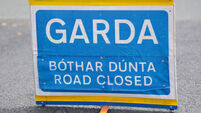Bottlehill battle still goes on after the war is lost
After a five-and-a-half year campaign, residents of Bottlehill have had to accept the inevitable.
They are not naive. Despite dogged determination they know they probably lost the war because they were earmarked as one of three possible sites the others being Grenagh and Watergrasshill, both of which had bigger populations and thus generated far more vocal opposition.
That's not to say that the Bottlehill Environmental Alliance (BEA) didn't put up a major fight. It did. Any general would have been proud of the defence put up, despite what was perceived by many as a hopeless position.
"We didn't have the population numbers, or a strong political hitter. We were in an area divided by the Cork East and Cork North Central constituencies and that didn't help either," BEA spokesman John O'Riordan said.
He has welcomed the decision by Cork County Council to proceed with appointing an environmental monitoring committee, following a report produced by an independent consultant, Dr Harriet Emerson.
This committee will comprise of community representatives from Bottlehill, Mourneabbey, Carrignavar and possibly other villages. In addition it will include public representatives, and officials from the local authority.
"It is critically important that the local community have confidence in the membership of the monitoring committee and the terms of reference within which it will operate. It will be seen by the local community as security and protection of their future living in this area," Mr O'Riordan said.
"As a result of three oral hearings and five-and-a-half years of a battle against the landfill, the people in the area know only too well the possible risks associated with a development of this scale."
And it's on a potentially massive scale, amid 200-plus acres of forestry, with a lifespan (at the moment) of 20 years.
The creation of a monitoring committee was part of the conditions granted by Bord Pleanála and the Environmental Protection Agency (EPA).
"The monitoring committee will have a serious job of work and will need to be in a position to ensure that the facility will comply with the waste license issued by the EPA, and the grant of permission from An Bord Pleanála and that this monitoring committee will have teeth and won't be just a talking shop," Mr O'Riordan added.
BEA has already compiled a 'top' 18-point check list which includes upgrading narrow country roads leading to the site; monitoring local wells, streams and rivers for pollution and vermin control.
John Howard, chairman of Carrignavar Community Council, said the people he represents have very genuine concerns. The parish, which has a population of around 3,000 people, borders the outer ring of the dump.
"Our main concern at the moment is proper representation on the monitoring committee. We want to be in a position to make sure the dump is properly set up," Mr Howard said.
He pointed out that a lot of streams ran through the area and as such any pollution caused by leachate run-off could be disastrous.
"We are also worried about property values. These would be our two main concerns. Also the roads in the area wouldn't be up to standard (to carry large amounts of refuse trucks) and they need vast improvements," the community council chairman added.
"A commitment has been given to us to say what should happen there. If we are taking the county's refuse then we should have concessions."
THE PARISH of Glenville is just 1.5km from the site, although the village itself is double the distance away. People living there have similar concerns, as was pointed out by Glenville Community Council chairman Raymond Barry.
He wants to ensure that in the years ahead the landfill doesn't encroach even further into the vast Bottlehill forestry.
"There's a genuine fear out there that it will expand even more. Roads around here are quite narrow and trucks will be passing through from Cork, and maybe even further afield to the site," Mr Barry said.
In an area which is known for its agriculture, there is naturally a concern over contamination, and the spread of vermin.
"The fishing people are concerned about the purity of water in the area. We have tributaries which feed the River Bride (a well known trout fishery). There is also a possibility that there will be a contamination of wells," Mr Barry added. This might sound extraordinary, but he maintains that locals are even more fearful that in the years ahead that an incinerator may be planted smack bang in the middle of the Bottlehill site.
"There is a genuine fear out there. It is in an elevated area and a sparsely populated area. Incinerators have been placed in areas like this before in other parts of Europe," Mr Barry said.
There is also to be representation on the committee from Mourneabbey, which hasn't pleased some people, especially farmer John Cahill who was an independent objector to the dump.
Much of his land borders the site. The farm is fragmented and he has to drive his cows four times a day to and from the milking parlour down narrow country roads which are soon to roar to the sound of scores of refuse trucks.
"It's my livelihood and I'm afraid I'll be written off the map.
"The volume of traffic coming to the site will make it nearly impossible to move my cows," Mr Cahill said.
He believes, and with some justification, as being one of those most affected that he should sit on the environmental monitoring committee.
"I have written to the county council requesting this and I've been told I will be represented by BEA. They're not representing me," he said.
"Mourneabbey is nearly 10 miles down the road from Bottlehill. It's ridiculous they should have representation when I haven't. Surely be to God it's common sense."













